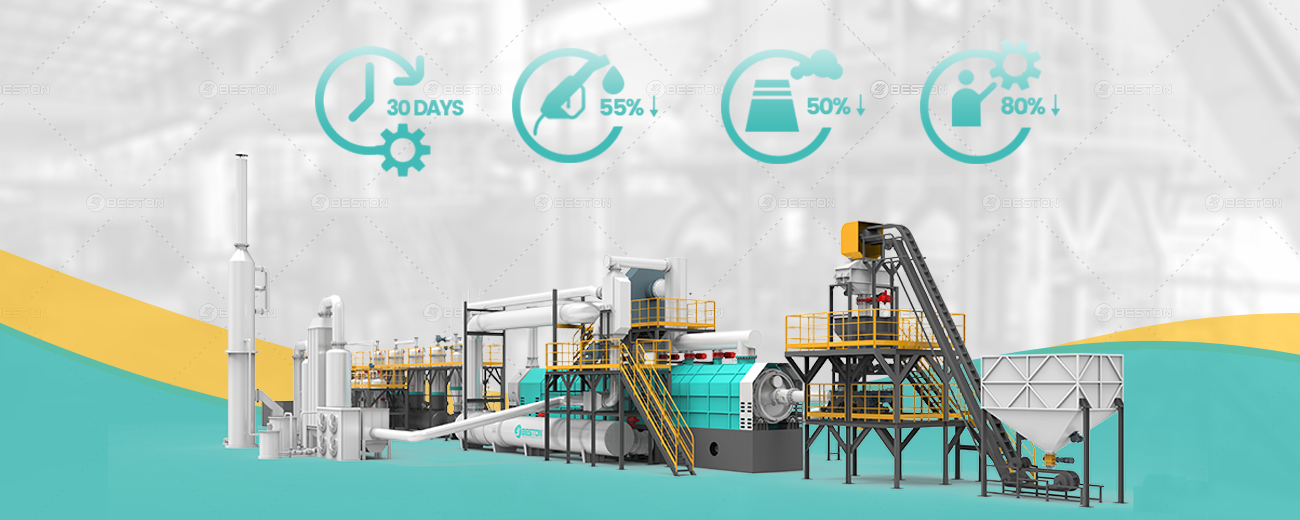The global tire industry faces escalating scrutiny over its environmental footprint. With over one billion end-of-life tires (ELTs) generated annually, traditional disposal methods—landfilling and incineration—have proven inadequate and unsustainable. Pyrolysis offers a regenerative alternative, enabling the tire industry to recover value from its own waste stream. A pyrolysis plant, when deployed at scale, becomes a linchpin in creating a closed-loop system for rubber products.
Conventional disposal methods treat used tires as waste rather than as feedstock. Pyrolysis reverses this perspective. Through thermal decomposition in an oxygen-deficient environment, vulcanized rubber undergoes depolymerization, yielding three valuable outputs: tire pyrolysis oil (TPO), recovered carbon black (rCB), and non-condensable gas. Each of these has a direct or substitutive role in industrial operations, effectively displacing virgin raw materials.
Unlike mechanical shredding or crumbing, which preserve physical structure but degrade chemical quality, pyrolysis dismantles tires at the molecular level. This unlocks pathways to reuse previously inaccessible components.
Recovered carbon black from a tyre pyrolysis plant exhibits reinforcing properties suitable for rubber compounding, albeit with post-treatment. When refined, rCB can replace up to 30% of virgin carbon black in new tire formulations. This substitution not only reduces fossil-based input demand but also decouples material supply from volatile petroleum markets.
Tire pyrolysis oil, a hydrocarbon-rich liquid, can be utilized as an alternative fuel or chemically upgraded to produce petrochemical intermediates. With proper fractional distillation and desulfurization, TPO enters the circular chain as a substitute for heavy fuel oil or naphtha in refineries.
The non-condensable fraction—primarily hydrogen, methane, and light hydrocarbons—fuels the pyrolysis reactor itself, creating a semi-autonomous energy loop. In some configurations, excess syngas is diverted for power generation, converting waste rubber into distributed energy.

Legislative bodies in Europe, North America, and parts of Asia are intensifying restrictions on tire landfilling and open burning. Extended Producer Responsibility (EPR) frameworks now compel tire manufacturers to account for post-consumer product fate. A continuous pyrolysis plant integrated within tire recovery networks offers compliance with these mandates while generating revenue from valorized byproducts.
Moreover, carbon offset protocols are emerging for emissions avoided via waste-to-resource systems. Properly documented pyrolysis operations may qualify for voluntary carbon markets, reinforcing economic viability.
Pyrolysis enables geographic decentralization of tire waste processing. Rather than transporting bulky ELTs across long distances to centralized disposal facilities, modular pyrolysis units can be deployed near collection points or tire manufacturing plants. This reduces logistical emissions and operational overheads.
The integration of a pyrolysis plant into industrial parks opens avenues for symbiotic relationships—carbon black reuse by local manufacturers, fuel oil consumption by nearby cement kilns, and waste heat recovery for ancillary operations. This multi-sectoral integration fortifies the circular economy not only within the tire industry but across adjacent sectors.
While early pyrolysis systems were rudimentary and batch-based, technological evolution has yielded fully continuous pyrolysis systems with automated feedstock handling, real-time monitoring, and advanced emissions control. Modern reactors achieve higher yield stability, consistent rCB quality, and scalable throughput—all essential for industrial reintegration.
Innovations such as catalytic cracking, vacuum pyrolysis, and microwave-assisted systems continue to improve product purity and energy efficiency. These enhancements further align the process with the requirements of high-grade reuse.
Tire pyrolysis is more than waste management—it is a strategic process that reintroduces discarded materials into value-generating circuits. Through chemical recovery and material recirculation, the pyrolysis plant bridges the linear and circular economies. As regulatory pressure intensifies and sustainability becomes a core market driver, pyrolysis technology positions itself not as an auxiliary solution but as a structural necessity. Its role in redefining the lifecycle of tires underscores the shift from extraction to regeneration in the global materials economy.